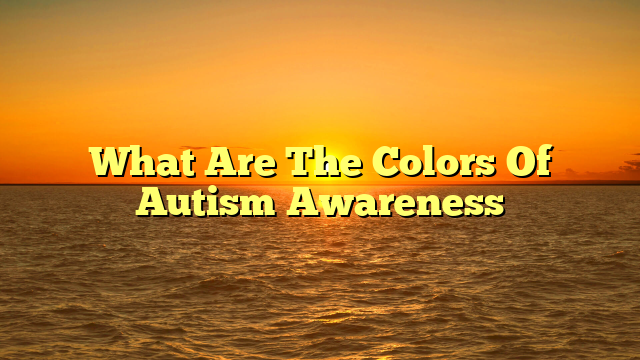Autism awareness is an important topic that brings attention to the experiences of individuals on the autism spectrum. One way to show support and raise awareness is through the use of specific colors. So, what are the colors of autism awareness? Let’s find out!
When it comes to autism awareness, the puzzle piece symbol is often associated with the cause. The puzzle pattern represents the complexity of autism and the many different pieces that make up the autism community. As for colors, the most recognized color for autism awareness is a vibrant shade of blue. This hue reflects strength, unity, and understanding.
However, it’s important to note that autism awareness is not limited to just one color. In fact, a variety of colors are used to represent different aspects of autism. From blue to red, yellow to green, each color holds its own significance in spreading awareness and promoting inclusivity.
So, whether it’s wearing a blue ribbon or displaying a colorful puzzle piece, showing support for autism awareness is a powerful way to make a difference. Together, we can create a world that embraces and understands individuals on the autism spectrum. Let’s celebrate the diverse colors of autism awareness and foster a more inclusive society.
The Colors of Autism Awareness: Understanding the Symbolism Behind Each Hue
Autism awareness is a cause close to the hearts of many individuals and communities around the world. To spread awareness and show support for those on the autism spectrum, specific colors have become associated with autism awareness. Understanding the symbolism behind each hue not only helps raise awareness but also fosters inclusivity and support for individuals with autism and their families. In this article, we will explore the meaning behind the colors of autism awareness and how they play a significant role in spreading understanding and acceptance.
The Color Blue: Empathy and Harmony
Blue is the most well-known color associated with autism awareness. It symbolizes empathy, understanding, and harmony. The color blue often represents calmness and tranquility, qualities that are beneficial for individuals on the autism spectrum who may experience sensory sensitivities. Blue has become synonymous with autism awareness through initiatives like Autism Speaks’ “Light It Up Blue” campaign during Autism Awareness Month in April. By wearing and displaying blue ribbons or lighting up buildings in blue, individuals and communities show their support and advocate for a more inclusive society.
Blue also signifies the challenges individuals with autism face in social communication and interaction. It reminds us that empathy and understanding are crucial in creating a world where individuals with autism can thrive. By promoting the color blue, we aim to foster an environment where autistic individuals are embraced with open arms and accepted for who they are.
The Color Red: Uniting and Advocating for Autism
While blue is the most recognized color for autism awareness, the color red has gained significance in recent years. Red represents the rallying call to advocate for the rights and needs of individuals with autism. It symbolizes the passionate fight for education, support, and acceptance.
Incorporating red into autism awareness campaigns helps individuals and communities come together, inspiring action and positive change. Red also highlights the urgency of ensuring equal opportunities and resources for individuals on the autism spectrum. By wearing red ribbons, hosting events, or sharing information on social media, advocates can ignite conversations and push for a more inclusive society.
The Color Yellow: Empowerment and Hope
Yellow is a color often associated with optimism, energy, and hope. It serves as a symbol of empowerment for individuals on the autism spectrum and their families. The color yellow encourages us to celebrate the unique strengths and abilities of autistic individuals and highlights their potential for growth and success.
When used in autism awareness initiatives, yellow emphasizes the importance of early intervention and access to quality therapies and services. It reminds us that with the right support, individuals with autism can thrive and lead fulfilling lives. By wearing yellow accessories, such as ribbons or clothing, we show solidarity and support for autistic individuals while spreading a message of hope.
The Color Green: Nature, Growth, and Acceptance
Green, a color deeply connected to nature and growth, represents acceptance and understanding within the autism community. It signifies the importance of creating an environment that embraces neurodiversity and allows individuals on the spectrum to flourish.
The color green reminds us of the need to provide inclusive educational settings, employment opportunities, and community support for individuals with autism. By promoting green in autism awareness campaigns, we advocate for the creation of safe and accepting spaces where all individuals, regardless of their neurodiversity, can thrive and reach their full potential.
The Color Purple: Individuality and Creativity
Purple is a color that evokes individuality, creativity, and imagination. It symbolizes the unique talents and perspectives of individuals with autism. By embracing the color purple, we highlight the importance of recognizing and nurturing the creative abilities of autistic individuals, which can often be a significant source of strength and empowerment.
Purple also represents the need for society to be more flexible and accommodating of different thinking styles and approaches to problem-solving. By understanding and appreciating the diverse ways in which individuals on the spectrum view the world, we can foster inclusive environments that value and celebrate neurodiversity.
The Color Gold: Support and Awareness for Girls on the Spectrum
Gold is a color that represents support and awareness specifically for girls on the autism spectrum. Autism is often underdiagnosed or misdiagnosed in girls due to differences in presentation and symptoms. By highlighting the color gold, we shed light on the unique challenges faced by girls with autism and advocate for their needs to be recognized and met.
The color gold serves as a symbol of empowerment and solidarity for girls on the spectrum and their families. It encourages open dialogue and increased understanding of the experiences and strengths of autistic girls. By spreading awareness about the color gold, we can help ensure that every individual on the autism spectrum receives the support and resources they deserve.
The Power of Symbolism: Spreading Autism Awareness Through Colors
The Wider Impact: Beyond the Colors
The use of specific colors in autism awareness initiatives has played a vital role in shedding light on the challenges faced by individuals on the spectrum and advocating for a more inclusive society. These colors not only raise awareness but also serve as visual reminders of the importance of empathy, acceptance, and support.
It is important to remember that while colors are powerful symbols, true autism awareness goes beyond these hues. Building a more inclusive society involves educating ourselves, challenging stereotypes, supporting neurodiversity, and creating opportunities for individuals on the autism spectrum to express their unique talents and strengths.
By understanding the symbolism behind the colors of autism awareness, we can better appreciate the efforts of organizations, communities, and individuals working towards a world where individuals with autism are fully embraced and supported. Let us continue to spread awareness, advocate for inclusivity, and celebrate the strengths and contributions of autistic individuals.
Key Takeaways: What are the colors of autism awareness?
- The primary color associated with autism awareness is light blue.
- Light blue represents calmness and stability often sought by individuals with autism.
- Autism awareness also includes the use of puzzle pieces as symbols, which are usually multicolored.
- The puzzle pieces represent the complexity of autism and the diversity within the autism community.
- Other colors associated with autism awareness include red, yellow, and green, representing different aspects of autism.
Frequently Asked Questions
Welcome to our frequently asked questions section on autism awareness colors. Here, we will address common queries about the colors associated with promoting autism awareness.
1. Why are there specific colors associated with autism awareness?
The colors associated with autism awareness, which are predominantly blue and sometimes include other colors like red, yellow, and white, were chosen to symbolize the condition. Blue represents calmness and acceptance, while the other colors add vibrancy and support to the cause.
By using specific colors, it helps promote recognition and unity among individuals, families, and communities impacted by autism. It also serves as a way to initiate conversations about autism and raise public awareness about the challenges faced by those on the spectrum.
2. Do all countries use the same colors for autism awareness?
While blue is the most recognized color for autism awareness globally, it is important to note that different countries may have their own variations and additional colors associated with the cause. For example, in the United States, blue is the predominant color, while in Australia, the national color is a combination of red, yellow, and blue.
However, the underlying purpose of promoting autism awareness remains the same regardless of the specific colors used. It signifies a collective effort to support and advocate for individuals with autism and their families, regardless of geographical boundaries.
3. Are there other symbols associated with autism awareness besides colors?
Yes, apart from colors, there are several symbols associated with autism awareness. One of the most recognizable symbols is the puzzle piece, which represents the complexity and diversity of the autism spectrum. The puzzle piece signifies that each individual with autism is unique, and fitting together the puzzle represents fostering a more inclusive society.
Another symbol commonly used is the autism awareness ribbon, which is often displayed alongside the chosen colors. The ribbon serves as a visual representation of support and solidarity, prompting conversations and creating awareness about autism and its impact on individuals and families.
4. How can I show my support for autism awareness using colors?
There are many ways to show your support for autism awareness using the associated colors. You can wear clothing or accessories that feature the colors, such as blue or multicolored ribbons, bracelets, or badges. You may also consider decorating your social media profiles or websites with the colors to promote awareness online.
Participating in local or virtual autism awareness events is another impactful way to show support. These events often encourage participants to wear or display the colors associated with autism awareness, fostering a sense of community and showcasing solidarity with those on the autism spectrum.
5. Can I use other colors to support autism awareness?
Absolutely! While blue and the associated colors are widely recognized, there are no hard and fast rules when it comes to supporting autism awareness. If you feel connected to other colors that hold personal significance, such as purple or rainbow colors, you are free to use them to show your support.
Ultimately, the goal is to raise awareness and promote understanding, so any effort to engage in conversations or actions that contribute to a more inclusive and supportive society for individuals with autism is highly appreciated, regardless of the specific colors used.
Summary
Colors are used to raise awareness about autism, a condition that affects how people think and communicate. The most well-known color for autism awareness is blue, but there are other colors too. Each color represents a different aspect of autism, like acceptance, understanding, and support. It’s important to remember that every person with autism is unique, just like the colors that represent them.
Different organizations use different colors to raise awareness about autism, and people can choose any color that speaks to them personally. By wearing these colors or using them in campaigns, we can show our support for people with autism and spread awareness about their needs. So whether it’s blue, red, purple, or any other color, let’s embrace the different colors of autism and celebrate the diversity it represents.


















